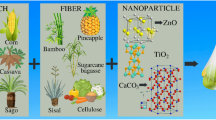Abstract
Used rubber powder was reinforced by corn stalk cellulose to prepare corn stalk cellulose/used rubber powder composites, and the coupling agents 3-mercaptopropyl trimethoxysilane (KH590), r-aminopropyltriethoxysilane (KH550), isopropyl dioleic (dioctylphosphate) titanate (HY101) and bis-(γ-triethoxysilylpropyl)-tetrasulfide (Si69) were used to modify the interphase between used rubber powder and corn stalk cellulose. The effects of corn stalk cellulose and coupling agent on the mechanical properties, thermal properties, interfacial morphology and structure of the composites were investigated, respectively. Results showed that the addition of corn stalk cellulose could effectively increase mechanical properties of the composites. Compared with untreated composites, the interfacial bonding between corn stalk cellulose and used rubber powder was significantly improved by the coupling modification treatment; while, mechanical properties, thermal properties, and compatibility of modified composites were further improved. On the whole, Si69 showed the best coupling modification effect, followed by KH590, then KH550 and HY101 in the case of coupling agent content, of which was all 6% of corn stalk cellulose content.








Similar content being viewed by others
References
Martina Z, Zbysek P, David C, Ondrej J, Milena P (2019) Eco-friendly concrete with scrap-tyre-rubber-based aggregate—properties and thermal stability. Constr Build Mater 225:709–722. https://doi.org/10.1016/j.conbuildmat.2019.07.168
Wu WL, Zuo HT (2016) Used tire rubber powder/plant cellulose composites treated with coupling agent. Cellulose 23:1939–1947. https://doi.org/10.1007/s10570-016-0952-8
Hoyera S, Krolla L, Sykuterab D (2020) Technology comparison for the production of fine rubber powder from end of life tyres. Procedia Manuf 43:193–200. https://doi.org/10.1016/j.promfg.2020.02.135
Qin L, Gao X (2019) Recycling of waste autoclaved aerated concrete powder in Portland cement by accelerated carbonation. Waste Manag 89:254–264. https://doi.org/10.1016/j.wasman.2019.04.018
Ramdania S, Guettalaa A, Benmalekb ML, Aguiarc JB (2019) Physical and mechanical performance of concrete made with waste rubber aggregate, glass powder and silica sand powder. J Build Eng 21:302–311. https://doi.org/10.1016/j.jobe.2018.11.003
Guptaa T, Siddiqueb S, Sharmaa RK, Chaudharyc S (2019) Behaviour of waste rubber powder and hybrid rubber concrete in aggressive environment. Constr Build Mater 217:283–291. https://doi.org/10.1016/j.conbuildmat.2019.05.080
Ling TQ, Lu Y, Zhang ZY, Li CQ, Oeser M (2019) Value-added application of waste rubber and waste plastic in asphalt binder as a multifunctional additive. Materials 12:1280–1297. https://doi.org/10.3390/ma12081280
Gibreil HAA, Feng CP (2017) Effects of high-density polyethylene and crumb rubber powder as modifiers on properties of hot mix asphalt. Constr Build Mater 142:101–108. https://doi.org/10.1016/j.conbuildmat.2017.03.062
Aoudia K, Azem S, Hocine NA, Gratton M, Pettarin V, Seghar S (2017) Recycling of waste tire rubber: microwave devulcanization and incorporation in a thermoset resin. Waste Manag 60:471–481. https://doi.org/10.1016/j.wasman.2016.10.051
Cheng XW, Huang S, Guo XY, Duan WH (2017) Crumb waste tire rubber surface modification by plasma polymerization of ethanol and its application on oil-well cement. Appl Surf Sci 409:325–342. https://doi.org/10.1016/j.apsusc.2017.03.072
Liao XX, Wei YC, Zhang HF, Zheng TT, Luo MC, Liao SQ (2020) Effect of N, N’-m-phenylene bismaleimide on mechanical performance of waste rubber powder sintered by high-pressure high-temperature method. J Rubber Res 23:41–46. https://doi.org/10.1007/s42464-019-00034-7
Kareem FAE, Ayman AW, Ramadan E, Mohamed HA (2018) Assessment of the properties of PP composite with addition of recycled tire rubber. Ain Shams Eng J 9:3271–3276. https://doi.org/10.1016/j.asej.2018.05.001
Dominic M, Joseph R, Begum PMS, Kanoth BP, Chandra J, Thomas S (2020) Green tire technology: Effect of rice husk derived nanocellulose (RHNC) in replacing carbon black (CB) in natural rubber (NR) compounding. Carbohyd Polym 230:115620. https://doi.org/10.1016/j.carbpol.2019.115620
He TS, Xu RS, Da YQ, Yang RH, Chen C, Liu Y (2019) Experimental study of high-performance autoclaved aerated concrete produced with recycled wood fibre and rubber powder. J Clean Prod 234:559–567. https://doi.org/10.1016/j.jclepro.2019.06.276
Yang JM, Lu XM, Zhang YQ, Xu JL, Yang YQ, Zhou Q (2020) A facile ionic liquid approach to prepare cellulose fiber with good mechanical properties directly from corn stalks. Green Energy Environ 5:223–231. https://doi.org/10.1016/j.gee.2019.12.004
Acknowledgements
This work was supported by 2019 Science and Graduate Innovative Research Project of Qiqihar University Heilongjiang Province, China (YJSCX2019060).
Author information
Authors and Affiliations
Corresponding author
Ethics declarations
Conflict of interest
The authors declared no potential conflicts of interest with respect to the research, authorship, and/or publication of this article.
Additional information
Publisher's Note
Springer Nature remains neutral with regard to jurisdictional claims in published maps and institutional affiliations.
Rights and permissions
About this article
Cite this article
Wu, W., Chen, F. Coupling agent-modified corn stalk cellulose/used rubber powder composites. J Rubber Res 23, 237–243 (2020). https://doi.org/10.1007/s42464-020-00053-9
Received:
Accepted:
Published:
Issue Date:
DOI: https://doi.org/10.1007/s42464-020-00053-9




